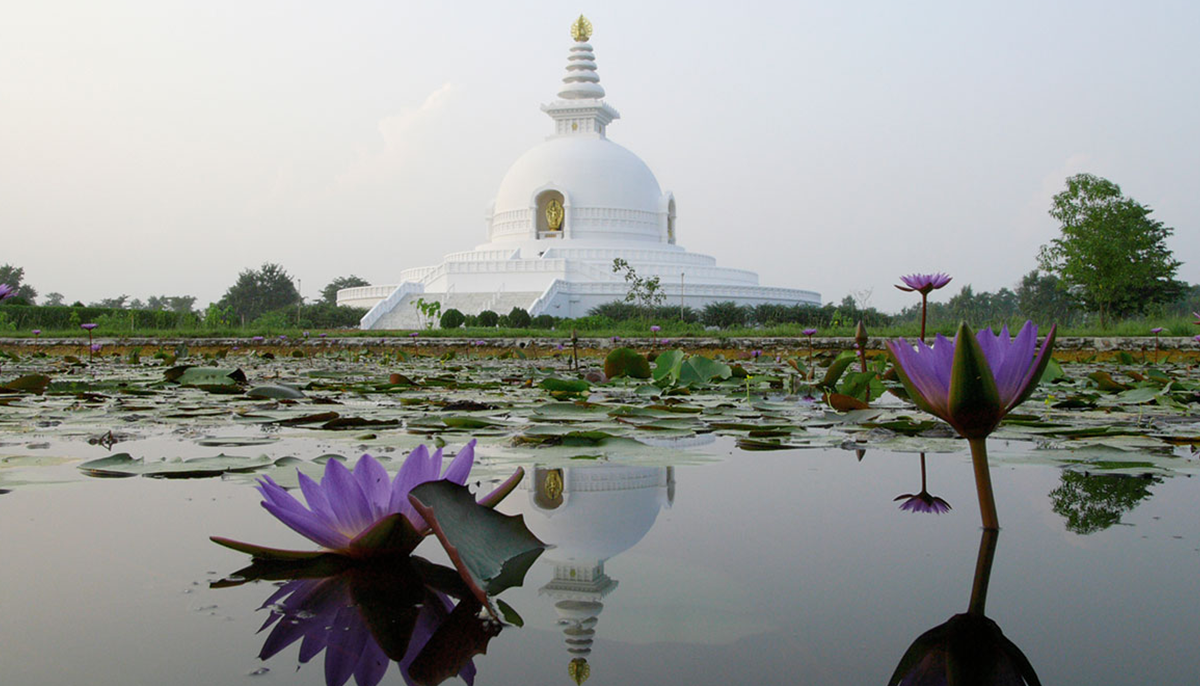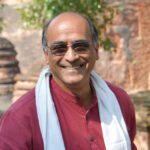As he lay on his deathbed, the Buddha comforted his distraught disciple Ananda by telling him there were four places that those with faith in the buddhadharma should visit. These four were the pleasure garden in Lumbini, where he’d been born; under the tree by the Niranjana River in Bodhgaya, where he’d awakened; in the Deer Park in Sarnath, where he’d first taught; and in the sal forest of Kushinagar where he would breathe his last. This was the Buddha’s way of saying that he could always be found wherever he’d walked and taught.
When we go on a pilgrimage like this, it is more than just travel. It is also an inner journey.
So over the past 2,600 years, millions of pilgrims have renewed and deepened their practice by visiting the four sites the Buddha listed. Plus, other places of significance to the Buddha’s life have been added to the pilgrimage circuit, such as Sravasti, where he spent twenty-four of his forty-five rain retreats, and Kapilavastu, where he spent his early years.
The entire pilgrimage route is within the span of about 350 miles east to west and 250 miles north to south, and the Buddha is known to have walked across it many times. These journeys would take him months, as he was often stopped for a few days at a time by people eager for his teachings.
He walked slowly, barefoot and mindful of each step. On bunds between rice fields, along rivers, on dusty village paths, and on the shady roadsides connecting the great cities of the time, he would be accompanied by a few of his disciples, each “leaving space between them for a cow to pass through.”
Carrying only his robes, alms bowl, water filter, and needle, the Buddha visited mango groves, sat by lotus ponds. Sometimes he’d sleep in the open air, sometimes in people’s homes. He, along with his monastic companions, would set off each morning on an alms round, stopping silently in front of each house without expectation. Sometimes, they’d be invited for meals at the home of one of the Buddha’s benefactors. After the meal, he usually shared a teaching, and this was an opportunity for his lay disciples to ask questions of him.
Some two hundred years after the Buddha’s death, the emperor Ashoka came to power. He dedicated so much of his time to spreading the Buddha’s teachings that, if it weren’t for him, it’s doubtful Buddhism would even exist today. Ashoka embraced the dharma after leading a genocidal war in Kalinga in which more than a hundred thousand people were killed. From then on, Ashoka vowed to travel only on pilgrimage, never for war and conquest. He went to many of the sites associated with the Buddha, putting up stone pillars as markers on the holy path. On some of the pillars there are inscriptions, carved in the Brahmi script, which describe how the place was associated with the Buddha and the sangha. These pillars helped archeologists of the late nineteenth century ascertain the authenticity and relevance of these sites.
There have been many great Buddhist pilgrims throughout history, some of whom have left records of the perilous journeys they undertook. Pilgrims, such as Faxian (337–422 CE) and Xuanzang (602–664 CE) came from China. They traversed the desolate Taklakaman Desert, facing everything from freezing cold to scorching winds, and then crossed the passes of the high Himalayas, finding the skeletal remains of earlier pilgrims as markers for their path. Other early pilgrims came from countries as far-flung as Korea, Japan, Tibet, Afghanistan, Bhutan, Sri Lanka, Vietnam, Thailand, Malaysia, Uzbekistan, and Greece.
This sacred journey in the footsteps of the Buddha is the way we can experience the very places the Buddha inhabited. We can still meet the sort of people he met, see what he saw, and come to understand his teachings in the context of the time in which he lived. Let’s take this sacred journey together.
Sarnath
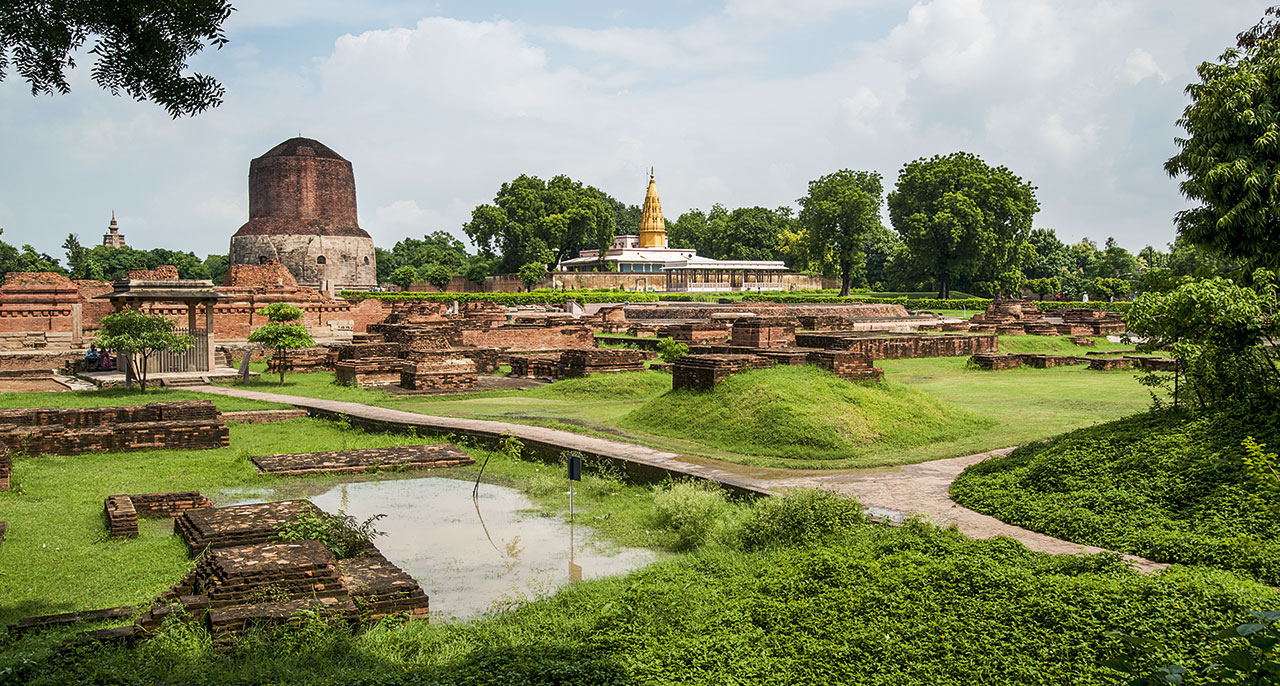
We begin our pilgrimage in Sarnath, entering the Deer Park with its old majestic neem trees. As we make our way toward the 150-foot-high cylindrical brick and stone stupa, we take each step mindfully, aware that we are walking in the Buddha’s own footsteps.
The Buddha had come here as soon as he left his place of enlightenment in Bodhgaya because he wanted to share the dharma with his former ascetic companions. Since Sarnath is 150 miles away from Bodhgaya, it took him a fortnight to walk here.
When the Buddha finally arrived, his former companions recognized him but decided not to greet him, as they felt he had fallen off the true path. But the luminosity of his presence was so overpowering that, despite themselves, they offered him water and a place to sit, and their skepticism fell away as they listened to the Buddha share what he had discovered. This was the first time he offered his revolutionary teachings on the middle way, the four noble truths, and the eightfold path, and it’s recorded that the eldest of the ascetics, Kondanna, immediately became fully awakened.
The Buddha stayed in Sarnath for the rest of that rainy season, allowing scores of people to hear him and become his disciples. It was also here where he offered his second crucial teaching on nonself, revolutionizing the spiritual thinking of his time. When finally leaving the area, he instructed his monks to each go in a different direction in order to carry his teachings far and wide.
Bodhgaya
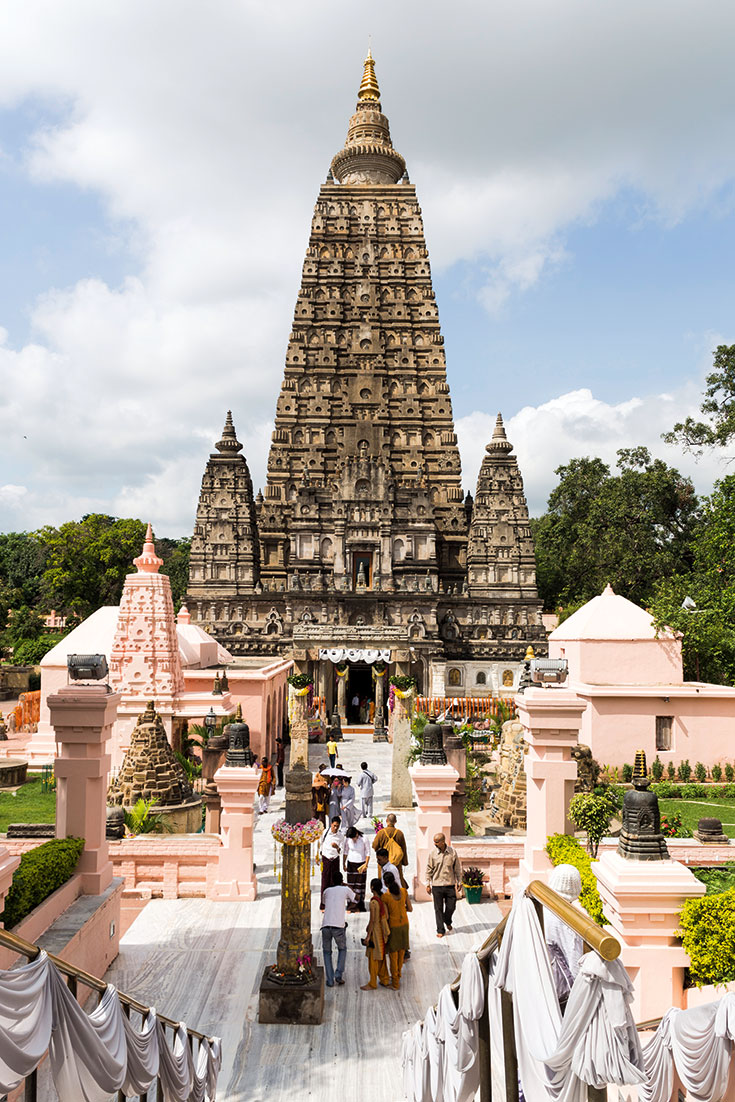
The Buddha himself then returned to Bodhgaya, the site of his enlightenment. Here, the most important place for the modern-day pilgrim is the stone slab under the Bodhi Tree, marking the exact spot where the Buddha awakened. The brick Mahabodhi temple was built at the site about 1,600 years ago and is visited every year by millions of pilgrims from all over the world. It’s a beautiful, 180-foot-high, pyramidal temple with a stupa finial. In the sanctum sanctorum there’s a ten-foot gold-painted Buddha statue from the tenth century, the base of which depicts the earth goddess whom the Buddha invoked to witness his awakening.
It’s said that after the Buddha’s awakening, he spent a week sitting under the Bodhi Tree, just enjoying his new sense of freedom, and after that he spent a week each at six other sites that we can visit in the Mahabodhi temple complex: a place now known as the unblinking shrine, from which the Buddha gazed at the Bodhi Tree in gratitude and contemplation; a path where he regularly practiced walking meditation; a jeweled shrine in the place where he developed the understanding of dependent origination; the lake near where a king cobra is said to have protected the Buddha through a storm; and a tree under which he met merchants, who offered him food.
This temple complex is alive with multitudes of devout pilgrims, all practicing in their own unique traditions—prostrating, meditating, chanting, circumambulating, reciting texts, studying, praying, turning prayer wheels, using mala beads for meditation or recitation, lighting butter lamps and candles, and making offerings in the form of flowers, perfumes, mandalas, water, or even money. In the midst of this, we can hear the call to prayer from the mosque next door and the chanting from the nearby Hindu Jagannatha temple. There are also Hindu Shaivite shrines inside the Mahabodhi complex, which a Hindu priest tends to. It’s all somehow a harmonious melee.
Near the temple flows the Niranjana river, and you can walk along the banks as the Buddha did. The children you meet here and in the village are probably not very different from the children the Buddha met.
Rajgir
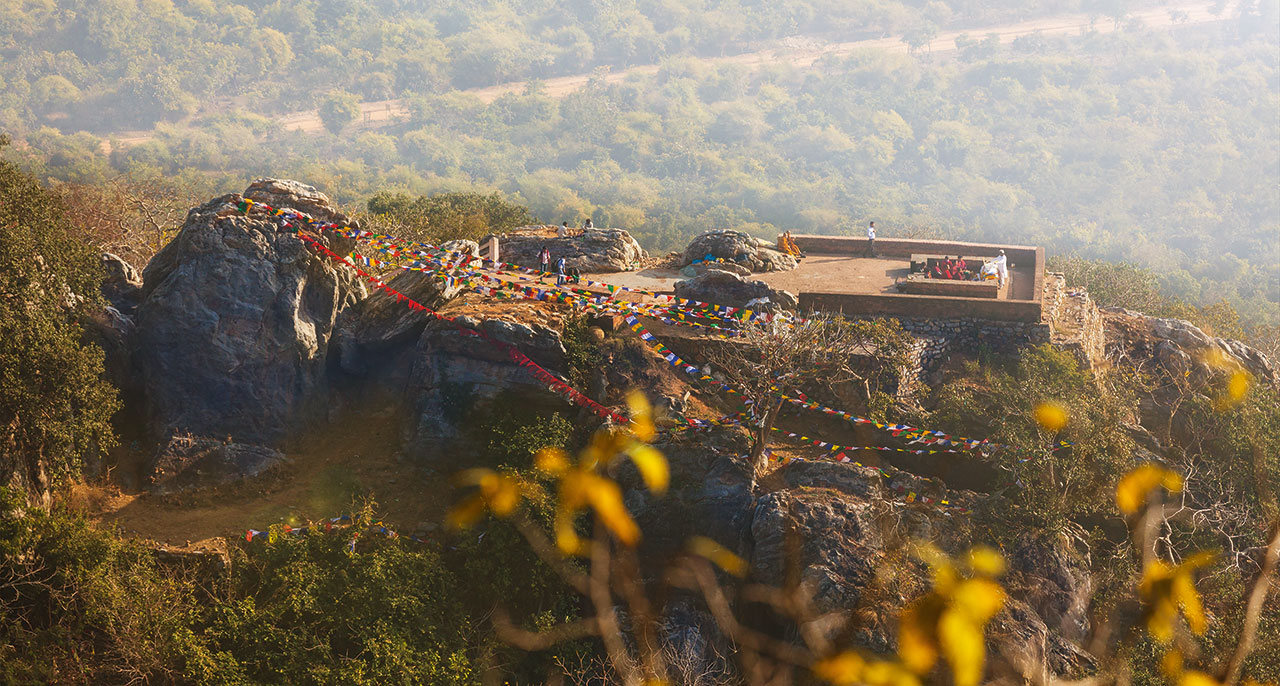
Traveling fifty miles farther along a chain of ancient hills is Rajgir. In this once ancient city the Buddha was offered his first gift of land, a bamboo grove, by the Magadhan king Bimbisara. Remains of the fortified city are still here, as are the hot springs where the Buddha bathed, and the cave where the first Buddhist Council was held a few months after his demise. But the most startling reminder of the Buddha’s presence in Rajgir is Vulture Peak, where he gave many important dharma talks. The area around it is a protected forest, so it still looks very much the same as it did 2,600 years ago.
Vaishali
Crossing the expansive Ganga river with its sandy islands, we come to Vaishali, where the Buddha met the courtesan Amrapali and accepted a meal at her mango grove. She then gave the grove to the Buddha. It was also here that he overturned his earlier decision not to admit women and welcomed about fifty nuns into the sangha, led by his stepmother, Queen Maha Prajapati Gautami. A hundred years after his death, the second Buddhist council was held in Vaishali, and much later—in 1958—archeologists found here the remains of a stupa that housed relics of the Buddha. They are now at the museum in nearby Patna.
The Buddha had his last rain retreat in Vaishali, and it was during this retreat that he confided to Ananda that he would die in three months. Then they started to walk north. The people of Vaishali followed, trailing them for thirty-five miles to Kesariya. To persuade the people to go back to their homes, the Buddha stopped and gave them his alms bowl. Today, there’s a huge stupa at Kesariya, which is said to have been the model for the Borobudur stupa in Java.
Kushinagar
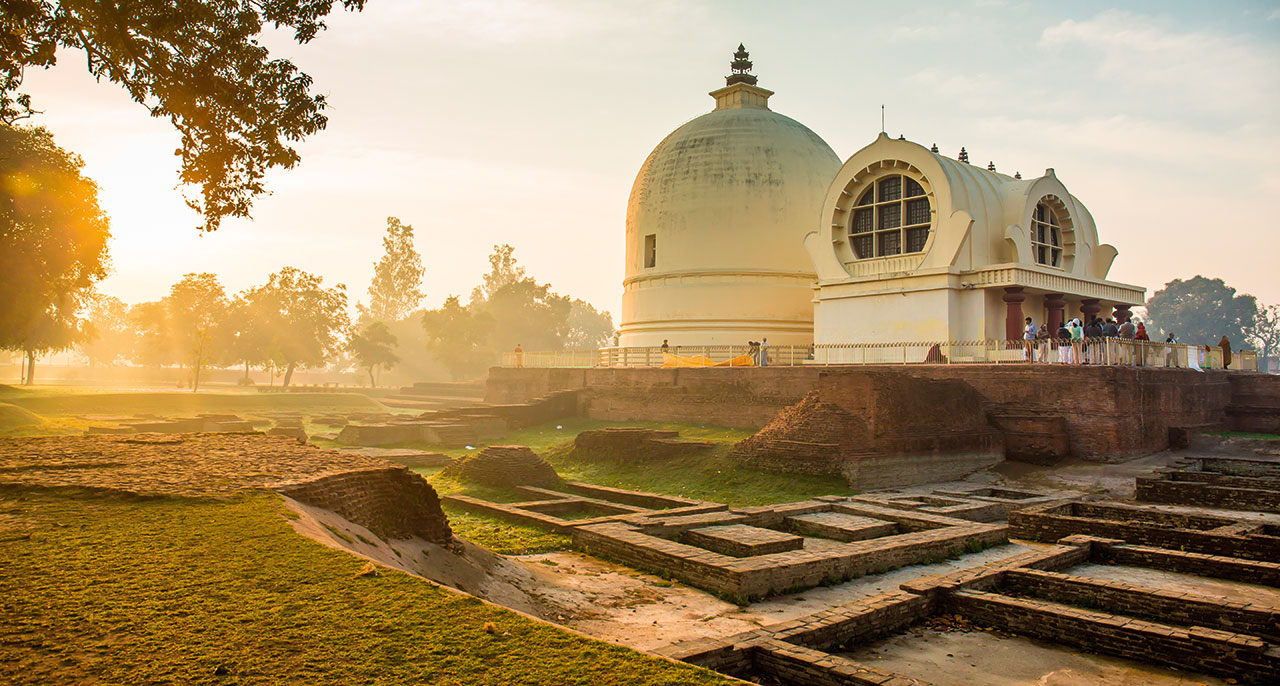
Another seventy-five miles north we come to Kushinagar, where the Buddha lay down to die in a forest, between twin sal trees, while flowers showered over him. Three times he asked the hundreds who had assembled if there was anything unclear about the teachings and practice, and each time there was silence, which implied that his teachings had been well understood. He closed his eyes, then he opened them one last time as the sun was setting. “All conditioned reality is subject to decay, strive on diligently,” he said. Those were his final words.
News of the Buddha’s passing spread and people kept arriving in large numbers. After a week, the Buddha’s body was taken to the Hiranyavati river bank to be cremated. As the cremation was about to start, a messenger came to say that the elder Maha Kashyapa was coming north with five hundred monks. Maha Kashyapa arrived, circumambulated the body three times, and then lit the pyre. There is now a beautiful stupa to mark that spot.
Even before the pyre had cooled down, a war almost broke out over the relics, until a local Brahmin priest suggested that they be divided so that each could get a share. Today, it’s poignant to sit by the eighteen-foot reclining Buddha statue in Kushinagar while contemplating his profound teachings on “no birth and no death.”
Lumbini
Traveling farther north, a few miles across the border from India into Nepal, we come to Lumbini, the Buddha’s birthplace. Late in her pregnancy, the Buddha’s mother, Queen Maha Maya, was traveling from her marital home to her mother’s home to deliver the baby. Midway into the journey, she stopped to rest in the beautiful pleasure garden at Lumbini, which bordered the Koliya and Shakya kingdoms. It’s said that as she rested in the garden, the labor pains began, and she walked over to a flowering tree and held onto one of its branches with her right arm while the baby was delivered. This image mirrors the tribal tradition of tree nymphs. Incidentally, all the Buddha’s major life events—his birth, awakening, and death—happened under trees and occurred on the full moon of the month of Baisakh, which is usually in May.
About a hundred miles east of Lumbini is Sravasti. Here we find the remains of an ancient city and a beautiful park, the Jetavana, another parcel of land donated to the Buddha’s sangha in his lifetime. This place is significant as the Buddha spent more time here than anywhere else. It’s where he offered his largest body of teachings and converted the dreaded serial killer Angulimala.
When we go on a pilgrimage like this, it is more than just travel. It is also an inner journey. We find that seeds are watered in our store consciousness that usually lie dormant inside us. It’s a wonderful way to know ourselves, as we have the opportunity to be more attentive to all that is going on inside and outside of us.
When we contemplate the Buddha’s teachings in the places he delivered them, they acquire a deeper meaning. We experience moments of awakening that renew our faith in the practices and teachings of the Buddha. We breathe with him. We walk with him. We meet the Buddha.
